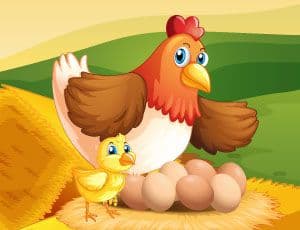Escola Games | Jogos Educativos
https://www.escolagames.com.br
Teacher's support sheet

Filling up Numbers
Chicken eggs to learn math? That's right! In Filling Up Numbers, Bibi, the chicken, needs help finding the numerical sequence the eggs are following. Pay close attention to discover what the logic is and hands-on!

Teacher's tips
Level of Education: Elementary School
Subject: Mathematics
Theme: Numerical sequence
Age: 06 to 10 years old
It is common to see groups of elements that come in a specific order, following a logical sequence. There are also numerical sequences in Maths. Teaching this content can be challenging, but using playful activities such as games can benefit the teaching-learning process. This game approaches these important mathematical structures for introductory education. [FIM-DICA]
Learner outcomes
To explore and recognize the numbers;
To identify regularities in the numerical sequence for naming, reading, writing, comparing, and ordering natural numbers;
To remember the characteristics of the decimal numbering system;
To formulate strategies for numerical writing by identifying the position occupied by the numbers;
To exercise logical reasoning by finding the missing numbers on the sequences;
To reinforce the content discussed during classes.;
To recognize regularities in numerical sequences through the analysis of the results of operations.
Teachers' goals
To offer situations in which students can analyze, interpret, and produce different numerical sequences;
To stimulate the taste for Mathematics through playful and pleasurable activities;
To offer the game as a didactic resource to explore the content discussed in the classroom;
To promote interaction and collaboration between classmates;
To explain that numbers are present in our daily lives and question them in which situations numerical sequences may appear;
To develop in students logical reasoning by establishing relations and comparisons between the numbers in the numerical sequence;
To stimulate the exchange of knowledge, socialization, and interaction between students.
Suggestions of approaches for the teacher
(Approach 1) Organize students in pairs or small groups to solve the problems. It is vital to highlight the strengths and weaknesses of each student so the exchange of ideas between classmates is efficient.
To register, ask students to write the first four numbers in each sequence. In groups, students will work with them.
They must find out the logic of each sequence and then create another logical sequence. For example: if you have the sequence 25, 30, 35..., you can form 12, 17, 22, 27, etc.
(Approach 2) It is essential to explore with students different types of sequences.
On the board, ask students to write examples of different sequences. Then, challenge them to create new ones, such as predecessor and successor, separation of even and odd numbers, and separation of units, tens, and hundreds.
(Approach 3) Give other examples related to numbers in our daily lives. Count by 10, by 100 from the year we are into 2500/3000.
Also, they can count by 60 as we count the hours.
And by 1000 as we count the kilometers.
(Approach 4) HOPSCOTCH
Make hopscotch using crayons. The numbers must form a logical sequence, and students must discover it. Make the game more difficult by replacing some numbers with symbols and asking students to guess the numerical sequence.
(Approach 5) Print images outlined by numerical sequences. To reveal the image, students must connect the sequence with a pen.
(Approach 6) NUMERICAL PUZZLE
Print different images in large size (A4 sheet). Then, glue them in cardboard so they are more resistant. Cut the image into rectangles and number them. Divide the room into groups and ask students to assemble the puzzle pieces. They must follow the number sequence to complete the drawing.
More about the content
Mathematical literacy is the ability to reason, represent, communicate, and argue mathematically to favor problem resolution using concepts, procedures, facts, and mathematical tools. Also, it is fundamental for students to recognize their place in the world. In addition, through this literacy, it is possible to develop critical thinking and stimulate investigation and logical reasoning. (BNCC 264).
The ability to solve problems, argue, and justify reasonings are some aspects directly related to mathematical literacy. They are all essential throughout life and must be developed from an early age. For students to be able to solve problems, argue, and learn to read, write, and speak mathematically, the classes must have challenging activities that favor group work, discussions of different points of view, and also reading and representing thoughts and conclusions.
Online games are a great ally in this process.
Here are other games of BEST SCHOOL GAMES that will help the development of these skills:
https://www.bestschoolgames.com/games/successorAndPredecessor/
https://www.bestschoolgames.com/games/numbersBattle/
